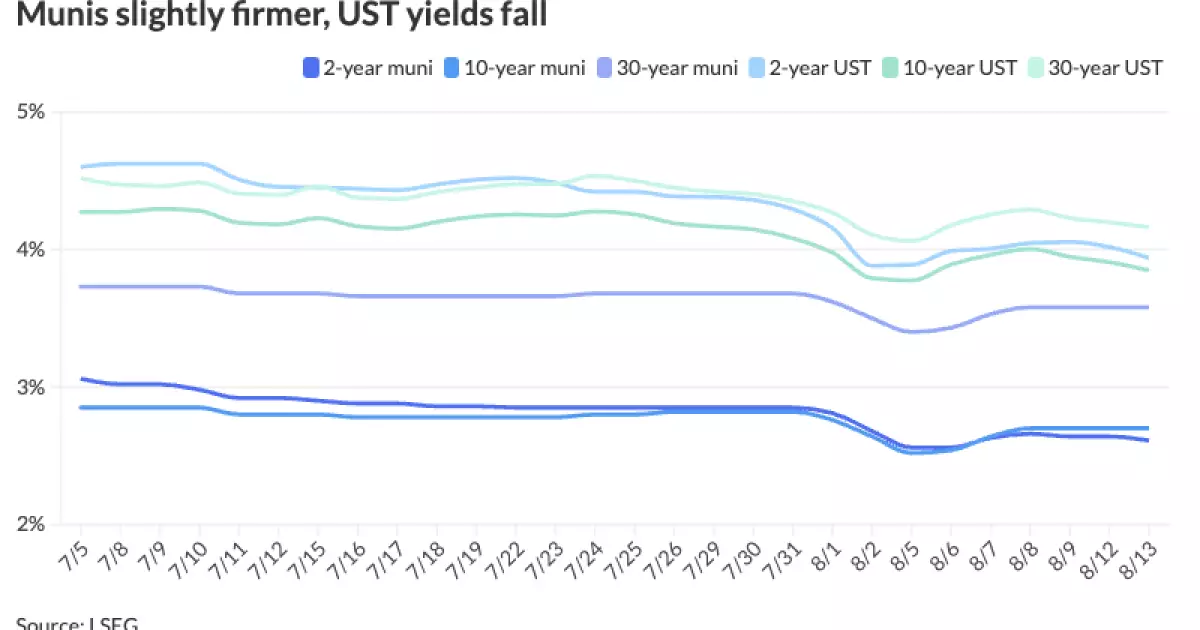Municipal yields have experienced a decline as the primary market activities gained momentum. However, this decline has been overshadowed by an improved performance in the U.S. Treasury market, especially as equities rallied following the release of lower-than-expected inflation data. This has led to two to four basis point increases in Triple-A municipal curves, with the most significant improvements seen in the short end of the market. On the other hand, Treasuries have shown movements of four to eight basis points, also with more pronounced changes in the short-term.
Despite the movements in yields, the muni to UST ratios have remained relatively stable, with different ratios observed across various maturity periods. The market seems to be reacting positively to a lighter new-issue calendar, with issuance for the week totaling an estimated $7.4 billion, significantly lower than the previous week. Additionally, the upcoming August 15 reinvestment is expected to inject about $21 billion into the market, providing further support during a relatively quiet calendar week. Analysts have highlighted that the technical backdrop appears supportive, emphasizing that employment data, rather than inflation, is more influential in the Fed’s decision-making process.
As the year progresses, the municipal market has been witnessing a substantial amount of primary supply, nearing the $300 billion mark. This trend is indicative of a potential total volume exceeding $450 billion by the end of the year. However, the evolving nature of municipal demand, particularly with negative net demand from banks and insurance companies, poses challenges. There have been notable fluctuations in exchange-traded fund redemptions, indicating varying investor behavior in response to market conditions. The test of demand durability will intensify as the Fed adjusts its target rate, affecting cash flows and fund allocations within the market.
Outlook and Market Activity
The evolving landscape of municipal investments underscores the need for underwriters to navigate changing demand dynamics by offering competitive prices and spreads. In the negotiated market, notable transactions include offerings by J.P. Morgan Securities LLC for the University of Houston, El Paso County Hospital District, Ohio, and the South Carolina Greenville-Spartanburg Airport District. These activities highlight the diverse nature of municipal bonds, catering to different issuers with varying financial needs. Similarly, competitive market sales by entities like the Miami-Dade County School District and the North Dakota Public Financing Authority further indicate the breadth of opportunities available in the market.
Various yield curve indicators provide insights into the performance of municipal bonds compared to U.S. Treasuries. The AAA scales from different data sources reveal fluctuations in yields across different maturity periods. While certain scales show improvements in yields, others demonstrate minor declines, signaling the complex interplay between market forces and investor sentiment. Simultaneously, U.S. Treasuries have shown improvements across different maturity periods, with varying degrees of changes in yields based on market conditions.
Upcoming Primary Market Offerings
Looking ahead, several entities are set to enter the primary market with diverse offerings. Entities like the California Community Choice Financing Authority, Triborough Bridge and Tunnel Authority, Maryland Economic Development Corporation, and others are gearing up for significant bond issuances. These offerings reflect the ongoing demand for municipal securities across different sectors and regions, showcasing the dynamic nature of the market. Investors and underwriters alike will need to closely monitor these developments to capitalize on emerging opportunities and navigate potential risks.
The state of municipal yields reflects a complex interplay of market dynamics, investor behavior, and macroeconomic indicators. While challenges persist, opportunities abound for market participants willing to adapt to changing conditions and capitalize on emerging trends. The critical analysis presented here aims to provide a nuanced understanding of the current municipal market landscape, offering insights that can guide informed decision-making and strategic investment choices.

